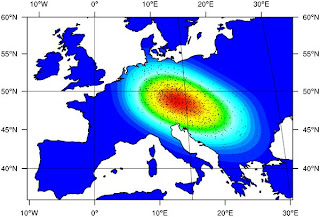A nice new paper proposes that Neandertal short legs were not due to adaptation to cold but related to gait efficiency in a mountainous environment. A short-legged person usually has to use more strides/time unit to keep up with a long-legged one. What the researchers have shown is that on a slope this is not the case.
An interesting thought came to me as I was reading this: if Neandertal short legs were not due to cold adaptation, could it be that early Homo sapiens long legs were also not due to adaptation for a tropical climate?
It has been generally believed that the longer legs of early Upper Paleolithic humans in Europe compared to Neandertals evidenced their fairly recent arrival from a much warmer region.
But, in an age when there was no alternative to walking, we would expect populations that migrated over long distances to be efficient walkers, or to become so, en route, due to natural selection ("those who can't keep up stayed behind"). Moreover, while all humans are pretty much capable of walking anywhere, we would expect the pioneers in every region colonized by our species to be longer-limbed, since they "got there first".
The reverse could also be true, depending on the environment one walked through: early colonists of mountainous regions might be rather short-legged, and this is exactly what we find in the
"hyper-polar" body types of early Neolithic farmers. These had to move across the fairly uneven terrain of southeastern Europe, at an age when there were no maps, no roads, and plenty of forest, making the shortest path between two points something different than a horizontal line.
The press
release explains things quite well:
While most studies have concluded that a cold climate led to the short lower legs typical of Neandertals, researchers at Johns Hopkins have found that lower leg lengths shorter than the typical modern human's let them move more efficiently over the mountainous terrain where they lived. The findings reveal a broader trend relating shorter lower leg length to mountainous environments that may help explain the limb proportions of many different animals.
...
"Studies looking at limb length have always concluded that a shorter limb, including in Neandertals, leads to less efficiency of movement, because they had to take more steps to go a given distance," says lead author Ryan Higgins, graduate student in the Johns Hopkins Center of Functional Anatomy and Evolution. "But the other studies only looked at flat land. Our study suggests that the Neandertals' steps were not less efficient than modern humans in the sloped, mountainous environment where they lived."
...
Neandertals, who lived from 40,000 to 200,000 years ago in Europe and Western Asia, mostly during very cold periods, had a smaller stature and shorter lower leg lengths than modern humans. Because mammals in cold areas tend to be more compact, with a smaller surface area, scientists have normally concluded that it was the region's temperature that led to their truncated limbs compared to those of modern humans, who lived in a warmer environment overall.
...
The researchers decided to study different types of bovids--a group of mammals including gazelles, antelopes, goats and sheep--since these animals live in warm and cold environments on both flat and hilly terrain. The group took data from the literature on bovid leg bones and found that they fit the pattern: mountainous bovids, such as sheep and mountain goats, overall had shorter lower leg bones than their relatives on flat land, such as antelopes and gazelles, even when they lived in the same climates.
Investigating closely related bovids brought this trend into even sharper relief. Most gazelles live on flat land, and the one mountainous gazelle species examined had relatively shorter lower legs, despite sharing the same climate. Also, among caprids (goats and sheep), which mostly live on mountains, the one flat land member of the group exhibited relatively longer lower legs than all the others.
"Biologists have Bergman's and Allen's Rules, which predict reduced surface area to body size and shorter limbs in colder environments," says Higgins. "Our evidence suggests that we can also predict certain limb configurations based on topography. We believe adding the topic of terrain to ongoing discussions about limb proportions will allows us to better refine our understanding of how living species adapt to their environments. This improved understanding will help us better interpret the characteristics of many fossil species, not just Neandertals."
Am J Phys Anthropol DOI: 10.1002/ajpa.21575
The effects of distal limb segment shortening on locomotor efficiency in sloped terrain: Implications for Neandertal locomotor behaviorRyan W. Higgins, Christopher B. Ruff
Past studies of human locomotor efficiency focused on movement over flat surfaces and concluded that Neandertals were less efficient than modern humans due to a truncated limb morphology, which may have developed to aid thermoregulation in cold climates. However, it is not clear whether this potential locomotor disadvantage would also exist in nonflat terrain. This issue takes on added importance since Neandertals likely spent a significant proportion of their locomotor schedule on sloped, mountainous terrains in the Eurasian landscape. Here a model is developed that determines the relationship between lower limb segment lengths, terrain slope, excursion angle at the hip, and step length. The model is applied to Neandertal and modern human lower limb reconstructions. In addition, for a further independent test that also allows more climate-terrain cross comparisons, the same model is applied to bovids living in different terrains and climates. Results indicate that:
(1) Neandertals, despite exhibiting shorter lower limbs, would have been able to use similar stride frequencies per speed as longer-limbed modern humans on sloped terrain, due to their lower crural indices; and (2) shortened distal limb segments are characteristic of bovids that inhabit more rugged terrains, regardless of climate. These results suggest that the shortened distal lower limb segments of Neandertals were not a locomotor disadvantage within more rugged environments.
Link




